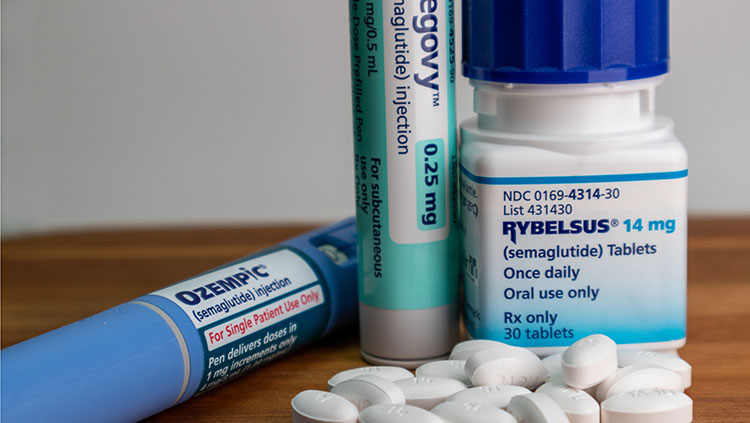Combating the Unwelcome Side Effects of GLP-1 Weight Loss Treatments
- Published20 Nov 2025
- Author Ailie McWhinnie
- Source BrainFacts/SfN

Patients on weight-loss drugs like Ozempic and Wegovy often quit within a year — not because the drugs don’t work, but because the side effects are intolerable. Scientists are scouring the brain to understand how these drugs act, with the hope of designing a new generation of treatments.
GLP-1 agonists like these mimic signals naturally released in the body after eating, controlling blood sugar, slowing digestion, and generating that ‘full’ feeling. These effects are helpful for weight loss but come with a glut of less desirable symptoms including muscle weakness, hair loss, and, most common of all, gastrointestinal issues like nausea and vomiting.
“Fifty percent of the people who stop taking GLP-1 therapies do so because of a side effect,” said Lorenzo Leggio, clinical director of the National Institute on Drug Abuse, speaking Nov. 17 in San Diego at Neuroscience 2025, the Society for Neuroscience’s annual meeting.
For these drugs to be effective, they need to be taken for extended periods. Stop too early, and the weight tends to return. Researchers are keen to identify which brain areas GLP-1 acts on to cause problematic side effects while also performing as a weight loss drug. The goal is to design a new wave of obesity treatments with more precise effects.
Separating Sickness From Satiety
Neurons sensitive to GLP-1 are found all over the brain and body, so it is no wonder these drugs have such diverse actions.
Warren Yacawych, researcher at the University of Michigan, introduced the brainstem as an area that could be responsible for unwanted side-effects. The brainstem is sensitive to GLP-1 and contains an “appetite center” which monitors nutrients entering the body to help determine when you feel full, but also a “vomit center” which responds to you eating something toxic by making you feel sick. It posed ideal locations for precisely targeting GLP-1 agonists — hit the appetite area, miss the vomiting center.
They found if neurons in the brainstem’s appetite center were shut down, mice with access to fatty food became more obese. However, directing GLP-1 drugs to this area alone to turn on those neurons did not cause weight loss. They had to target drugs to the vomit center, activating neurons there instead, to reduce body weight in mice. “We think it is very challenging right now to separate these side-effects, like nausea, from GLP-1’s intended effects,” Yacawych explained.
Targeting Cravings in the Brain
But the brainstem is not the only area sensitive to GLP-1 and thought to be involved in eating habits. For instance, “these drugs seem to be acting — in addition to other parts of the brain — on the emotion center, engaging the reward mechanisms of the brain,” said Ali Güler, researcher at the University of Virginia. This center, called the central amygdala, connects to the midbrain, which releases dopamine to power motivation for rewards.
We need energy to survive, so the brain is tuned to crave energy-dense, high-fat, and high-sugar foods. If GLP-1 can change how we process rewards, it might aid weight loss by suppressing cravings for high-calorie foods.
Exploring this idea, Güler’s team used a new type of GLP-1 drug that can be taken orally and is composed of much smaller molecules, making it easier to cross the blood-brain barrier.
By targeting the emotion center in mice, the drugs decreased mice’s consumption of more rewarding food, “like a burger.” But it didn’t affect their appetite for their standard food, “equivalent to eating a salad.” Targeting the emotion center specifically could encourage people to keep eating healthy foods and less of the unhealthy ‘rewarding’ foods, better supporting their overall health.
Some see precise targeting like this as the goal. “It is difficult to envisage targeting specific brain areas,” said Simon Luckman who works on GLP-1 independently of these three studies. This doesn’t make precise drug targeting an impossible task. Rather, it may require some creativity. “Drugs with differing access to the brain may have different effects,” he pointed out. He also noted combinations of drugs could block undesirable components.
Combining Strategies for Losing Weight
A cocktail of drugs may be a straightforward solution. Lower doses would be the easiest way to avoid side effects, but they would also mean less weight loss.
To get around this, a team at the University of Washington investigated the use of GLP-1 agonists in combination with oxytocin. The use of oxytocin may be surprising to some, given its fame as the ‘love hormone.’ But like most hormones, it has wider effects on the body and brain, helping regulate eating and body weight. The Washington team confirmed that combining a low dose of GLP-1 agonist (low enough to avoid nausea) with oxytocin can cause significant weight loss in rats.
Mireia Montaner, GLP-1 researcher at the University of Cambridge, said although there is still motivation to enhance GLP-1-based weight loss drugs, the idea of combining strategies, or even designing completely new ones, has “equal or even greater interest.” While these mixed approaches offer more feasible options for near-term improvements to obesity treatments than drug targeting to specific brain areas, scientists remain optimistic.
Understanding what makes each GLP-1 population unique, how different types of GLP-1 drugs move through the brain, and how they act on the brain versus the body will all be key to the challenge. “Not today,” said Leggio, on the prospect of specific targeting. “But there is hope for the future.”
CONTENT PROVIDED BY
BrainFacts/SfN
References
Gupta, T., Kaur, M., Shekhawat, D., Aggarwal, R., Nanda, N., & Sahni, D. (2023). Investigating the Glucagon-like Peptide-1 and Its Receptor in Human Brain: Distribution of Expression, Functional Implications, Age-related Changes and Species Specific Characteristics. Basic and Clinical Neuroscience, 14(3), 341–354. https://doi.org/10.32598/BCN.2021.2554.2
Hong, S. M., Ko, J. K., Moon, J. J., & Kim, Y. R. (2021). Oxytocin: A Potential Therapeutic for Obesity. Journal of Obesity & Metabolic Syndrome, 30(2), 115. https://doi.org/10.7570/JOMES20098
Zheng, Z., Zong, Y., Ma, Y., Tian, Y., Pang, Y., Zhang, C., & Gao, J. (2024). Glucagon-like peptide-1 receptor: mechanisms and advances in therapy. Signal Transduction and Targeted Therapy, 9(1), 234-. https://doi.org/10.1038/s41392-024-01931-z
Also In Diet & Lifestyle
Trending
Popular articles on BrainFacts.org



















